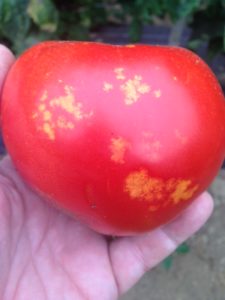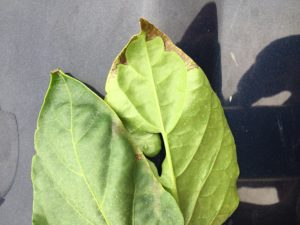Sweet Corn
European corn borer (ECB) moth captures have again declined to extremely low numbers, and no map will appear in this edition. Thus far, the second flight appears to be very weak, as is consistent with recent years’ second flights. Limited feeding should appear within 1-2 weeks, but may be obscured by fall armyworm (FAW) feeding by that time.
Growers should continue to scout whorl and pre-tassel stage plantings weekly and consider treating when infested plants exceed 12% in a 50 plant sample. As plantings proceed to the pre-tassel stage, ECB larvae may be found in emerging tassels. It is a good idea to treat individual plantings as they move into the full tassel/first silk stage one time. This eliminates any ECB larvae that have emerged with the tassels as they begin to move down the stalk to re-enter near developing ears.
Useful insecticides for this particular application include synthetic pyrethroids (IRAC Grp 3), spinosyns (including OMRI approved Entrust) IRAC Grp 5), and diamides such as Coragen (IRAC Grp 28) or materials such as Besiege which include the active ingredient in Coragen. Synthetic pyrethroids alone should NOT be used for corn earworm (CEW) protection on silking corn. Control with these materials is very inconsistent.
The highest nightly black light trap catches of ECB for the week ending 7/24/19 are as follows:
| Denville 2 | Old Bridge 1 |
| Dayton 1 | |
| Eldora 1 | |
| Long Valley 1 |
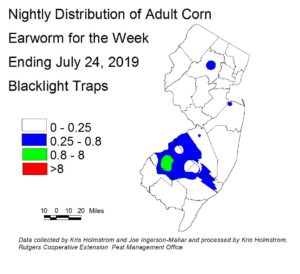 Corn earworm (CEW) moth catches have remained fairly steady (but highly variable) in blacklight traps, while pheromone traps have registered significant increases in some areas over the past week (see blacklight map at left, and pheromone trap map below at right). Catches from North Carolina remain highly variable, while Delaware’s catches are similar to our southern NJ catches while also exhibiting wide variability. While none of these catches indicate that a large scale migratory influx is underway, the trend has been gradual increase with scattered hot-spots. Red areas on the on the pheromone trap map indicate a 3-day silk spray schedule, while green indicates a 4-5 day silk spray
Corn earworm (CEW) moth catches have remained fairly steady (but highly variable) in blacklight traps, while pheromone traps have registered significant increases in some areas over the past week (see blacklight map at left, and pheromone trap map below at right). Catches from North Carolina remain highly variable, while Delaware’s catches are similar to our southern NJ catches while also exhibiting wide variability. While none of these catches indicate that a large scale migratory influx is underway, the trend has been gradual increase with scattered hot-spots. Red areas on the on the pheromone trap map indicate a 3-day silk spray schedule, while green indicates a 4-5 day silk spray 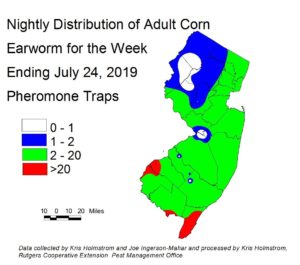 schedule. Blue areas represent a 5-6 day schedule, and white areas are 6-7 day. There are far fewer CEW pheromone traps than blacklights, and the resulting map has much broader color bands as a result. It should also be noted that the pheromone traps are much more sensitive than blacklights. Therefore, the number of moths caught in pheromone traps required to generate a specific spray interval is much higher than the number caught in blacklight traps. It must be stressed that there is high variability in these catches, and growers should consult with their IPM practitioner on recommended spray schedules.
schedule. Blue areas represent a 5-6 day schedule, and white areas are 6-7 day. There are far fewer CEW pheromone traps than blacklights, and the resulting map has much broader color bands as a result. It should also be noted that the pheromone traps are much more sensitive than blacklights. Therefore, the number of moths caught in pheromone traps required to generate a specific spray interval is much higher than the number caught in blacklight traps. It must be stressed that there is high variability in these catches, and growers should consult with their IPM practitioner on recommended spray schedules.
The highest nightly CEW pheromone trap catches for the week ending 7/24/19 are as follows:
| Green Creek 64 | Beckett 18 | Berlin 14 | Dayton 5 |
| Monroeville 23 | Eldora 16 | Matawan 6 | Farmingdale 4 |
| Pedricktown 19 | Woodstown 16 | Snyder Farm 6 | Jobstown 4 |
Fall Armyworm
Fall armyworm (FAW) feeding has been discovered as far north as Middlesex County, although percentages are low where it has appeared. We are entering the time of the season when FAW usually begins to increase, and this week’s disturbed weather may result in further FAW injury. Growers should scout all fields from pre-tassel stage down to early whorl stage. This pest causes extensive foliar damage on whorl stage corn (see photo at left), can also infest ears, and is capable of killing small plants. FAW larvae are brown in color (see photo at right), with an inverted
at left), can also infest ears, and is capable of killing small plants. FAW larvae are brown in color (see photo at right), with an inverted 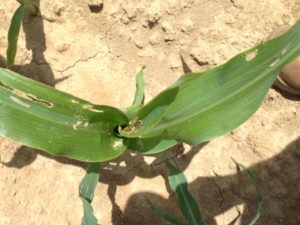 “Y” pattern on their head capsule. They are much larger than ECB when fully developed. FAW is even more consistently resistant to pyrethroid insecticides. For this reason, the same insecticides classes now recommended for CEW control should be utilized for FAW management.
“Y” pattern on their head capsule. They are much larger than ECB when fully developed. FAW is even more consistently resistant to pyrethroid insecticides. For this reason, the same insecticides classes now recommended for CEW control should be utilized for FAW management.
Silking Spray Schedules*:
South – 3-4 days
Central – 4-5 days
North – 5-6 days
*These recommendations are based on regional catches. Adhere to tighter spray schedules if indicated by local trap catches. To repeat: Synthetic pyrethroids alone should NOT be used for corn earworm (CEW) protection on silking corn, or for fall armyworm (FAW) management at any stage. Control with these materials is very inconsistent.
Tomatoes
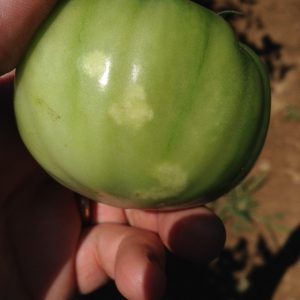 Stinkbug activity in tomato fields is increasing. These insects feed on fruit, causing the characteristic “cloudy spot” injury (see photos at left). Stinkbug nymphs cannot fly, and will feed extensively on fruit in discrete locations. Often picking crews detect feeding first, due to the volume of fruit they handle. If feeding is increasing or immature stinkbugs are detected in fields, or adults are detected at more than one site in a ten site sample, consider insecticide applications to limit injury. Consult the Tomato Section of the 2019 Commercial Vegetable Recommendations for suggested materials.
Stinkbug activity in tomato fields is increasing. These insects feed on fruit, causing the characteristic “cloudy spot” injury (see photos at left). Stinkbug nymphs cannot fly, and will feed extensively on fruit in discrete locations. Often picking crews detect feeding first, due to the volume of fruit they handle. If feeding is increasing or immature stinkbugs are detected in fields, or adults are detected at more than one site in a ten site sample, consider insecticide applications to limit injury. Consult the Tomato Section of the 2019 Commercial Vegetable Recommendations for suggested materials.
As yet, no pepper weevils have been captured on traps placed near southern NJ pepper fields.
Bacterial leaf spot infections continue in fields throughout the state. Dark lesions at the leaf margins, with a water-soaked appearance are typical of this disease (see photo at right). If lesions occur on young leaves that have not fully expanded, the leaves will distort as they mature. Plants will begin to drop infected leaves, resulting in a higher potential for sun scald on the fruit. Growers should consult the Pepper Section of the 2019 Commercial Vegetable Production Guide for suggested treatments, and maintain adequate fertility to the plants to encourage new canopy growth.
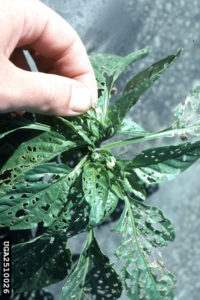 Pheromone traps established for beet armyworm (BAW) in the southern counties continue catching adults. At this time, most activity is in the Woodstown (28/night – an increase over the past week) and Jones Island (10/night) areas, with low numbers also occurring near Folsom (3) and Pedricktown (2). This pest can reach levels that result in damage to pepper plants, although this does not occur each year. Growers in the southern counties should be alert for the appearance of severely defoliated terminals (see photo at left) on pepper plants. Small BAW larvae feed on these leaves before turning to fruit as they increase in size. As with FAW, beet armyworm is resistant to pyrethroid insecticides. Insecticides now recommended for CEW and FAW control are useful for BAW management.
Pheromone traps established for beet armyworm (BAW) in the southern counties continue catching adults. At this time, most activity is in the Woodstown (28/night – an increase over the past week) and Jones Island (10/night) areas, with low numbers also occurring near Folsom (3) and Pedricktown (2). This pest can reach levels that result in damage to pepper plants, although this does not occur each year. Growers in the southern counties should be alert for the appearance of severely defoliated terminals (see photo at left) on pepper plants. Small BAW larvae feed on these leaves before turning to fruit as they increase in size. As with FAW, beet armyworm is resistant to pyrethroid insecticides. Insecticides now recommended for CEW and FAW control are useful for BAW management.
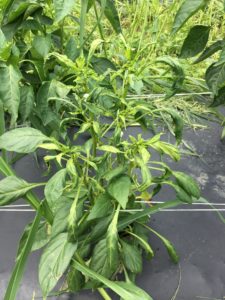 In the northern counties, several cyclamen mite infestations have been observed. These mites are too small to be seen without a microscope, and their presence is detected by their characteristic injury to foliage and fruit. Typically, clusters of plants begin to show distortion o
In the northern counties, several cyclamen mite infestations have been observed. These mites are too small to be seen without a microscope, and their presence is detected by their characteristic injury to foliage and fruit. Typically, clusters of plants begin to show distortion o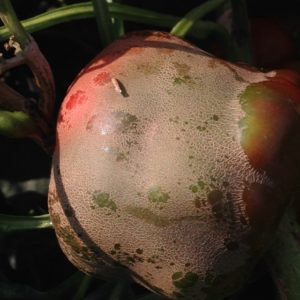 n new growth (see photo at left), while older, fully expanded leaves remain normal. As mites feed in blossoms, developing fruit exhibit extensive zippers and may even be fully russetted (see photo at right). Miticides labeled for spider mites are effective against cyclamen mites. See the Pepper Section of the 2019 Commercial Vegetable Production Guide for suggested materials. Resumption of normal foliar growth is an indication that treatments have been successful.
n new growth (see photo at left), while older, fully expanded leaves remain normal. As mites feed in blossoms, developing fruit exhibit extensive zippers and may even be fully russetted (see photo at right). Miticides labeled for spider mites are effective against cyclamen mites. See the Pepper Section of the 2019 Commercial Vegetable Production Guide for suggested materials. Resumption of normal foliar growth is an indication that treatments have been successful.
Pumpkins and Winter Squash
Note that cucurbit downy mildew (CDM) has been discovered on multiple cucurbit crops in southern NJ, as per Dr. Andy Wyenandt’s Pest Alert of 7/20/19. As of this Tuesday (7/23/19), CDM has not been detected on the sentinel plot now established at Snyder Farm in Hunterdon County, nor on scouted fields in northern NJ. Nonetheless, this week’s rains may have moved spores into new parts of the state, and all growers should be scouting for CDM and applying appropriate fungicides on all cucurbit crops at this time. For regional information on this important disease, see the Cucurbit Downy Mildew Forecast webpage: http://cdm.ipmpipe.org/. This weeks’ forecast has NJ at high risk(through Tuesday) of infection from sources to our south.
Brown Marmorated Stink Bug (BMSB)
 BMSB numbers in blacklight traps have increased over the past week (see BMSB map at left), as have all stinkbug species. We have captured enough BMSB this week to generate a map image. While this pest has generally declined as a threat to peppers, it remains a significant threat to tree fruit.
BMSB numbers in blacklight traps have increased over the past week (see BMSB map at left), as have all stinkbug species. We have captured enough BMSB this week to generate a map image. While this pest has generally declined as a threat to peppers, it remains a significant threat to tree fruit.
The highest nightly catches of BMSB in black light traps for the week ending 7/24/19 are as follows:
| Centerton 8 | Farmingdale 3 | Medford 2 |
| Monroeville 7 | Pedricktown 3 | Hillsborough 1 |
| Flanders 4 | Crosswicks 2 | New Egypt 1 |
| Matawan 4 | Denville 2 | Woodstown 1 |
